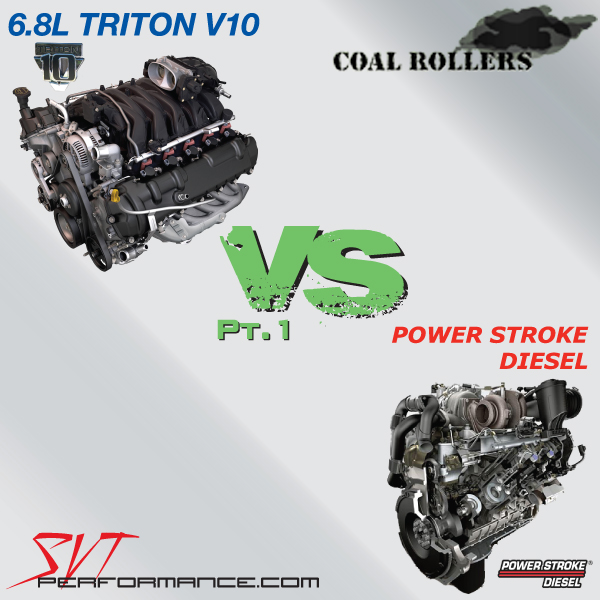
Can a V10 put more power to the ground than a PSD? Through the use of gearing could the superior revving capabilities of the V10, along with the torque multiplication of lower gears, overcome the low end grunt of a diesel? The common consensus among diesel owners is that the gas motor has no chance at towing as well as a diesel. However, I suspect this opinion is based in personal bias. As such I decided to try gathering some empirical data in an attempt to determine whether a V10 can be competitive with a PSD.
Well first we have to think about how the trucks are used and optioned. For this experiment I’m going to look at the truck I’m personally interested in, and the most popular sales wise, a SRW CC. I’m also going to assume the trucks have an auto tranny and 0% drivetrain loss. I know factoring in no drivetrain loss requires us to step out of the real world for a moment, but it’s consistent. Still, factoring in drivetrain loss would give the same outcome with different numbers because each combination should have roughly the same amount of parasitic loss. I’m also going to assume the truck is running at highway towing speeds (wanting to maintain between 65-70 mph). I am also going to assume that both trucks are unmodified. Since anything is possible with modding assuming the trucks are stock is the only way to be fair and consistent.
With the aforementioned conditions in mind we must first determine what speeds are possible in each gear. The 6.4 is pretty much out of breath at 3200 RPM, but 3000 RPM is the practical limit. The V10 makes its peak power at 4750RPM but pulls strong all the way to 5200RPM. The following speed determinations are made with 275/65R20 (stock size with 20 inch wheels) tires. These are the speeds that would be run in each gear, with the given rear axle ratio, and the given RPM:
5R110W - 3.55 gears at 3000RPM
1st (3.11) 27mph
2nd (2.22) 38mph
3rd (1.55) 55mph
4th (1.00) 85mph
5th (0.71) 120mph
5R110W - 3.73 gears at 3000RPM
1st (3.11) 26mph
2nd (2.22) 36mph
3rd (1.55) 52mph
4th (1.00) 81mph
5th (0.71) 114mph
5R110W – 4.10 gears at 4750RPM
1st (3.11) 37mph
2nd (2.22) 52mph
3rd (1.55) 75mph
4th (1.00) 117mph
5th (0.71) 175mph
5R110W – 4.30 gears at 4750RPM
1st (3.11) 36mph
2nd (2.22) 50mph
3rd (1.55) 72mph
4th (1.00) 111mph
5th (0.71) 152mph
ZF – 3.73 gears at 3000RPM
Low (5.79) 14mph
1st (3.30) 24mph
2nd (2.10) 38mph
3rd (1.30) 62mph
4th (1.00) 81mph
5th (0.72) 113mph
ZF - 4.30 gears at 4750RPM
Low (5.79) 19mph
1st (3.30) 33mph
2nd (2.10) 53mph
3rd (1.30) 86mph
4th (1.00) 111mph
5th (0.72) 155mph
4R100 - 3.73:1 gears at 3000RPM
1st (2.71) 30mph
2nd (1.53) 53mph
3rd (1.00) 81mph
4th (0.71) 114mph
2008 V10 (362 hp – 457 ft/lbs): produces about 80% of its peak torque (peak 457 ft/lbs, 80% of which is 366 ft/lbs) between 1000 and 4750RPM.
2008 6.4 (350 hp – 650 ft/lbs): produces about 80% of its peak torque (peak 650 ft/lbs, 80% of which is 520 ft/lbs) between 1300 and 3000RPM.
2004 6.0 (325 hp – 560 ft/lbs): produces about 80% of its peak torque (peak 560 ft/lbs, 80% of which is 452 ft/lbs) between 1300 and 3000RPM.
2002 7.3 (250 hp – 500 ft/lbs): produces about 80% of its peak torque (peak 500 ft/lbs, 80% of which is 400 ft/lbs) between 1200 and 3000RPM.
The following maximum torque output was calculated by multiplying the torque by the rear axle ratio and the transmission gear ratio:
2008 V10 w/4.10 (366 ft/lbs) in overdrive = 1065 ft/lbs
2008 V10 w/4.10 (366 ft/lbs) in 4th gear = 1500 ft/lbs
2008 V10 w/4.10 (366 ft/lbs) in 3rd gear = 2326 ft/lbs
2008 V10 w/4.30 (366 ft/lbs) in overdrive = 1117 ft/lbs
2008 V10 w/4.30 (366 ft/lbs) in 4th gear = 1573 ft/lbs
2008 V10 w/4.30 (366 ft/lbs) in 3rd gear = 2439 ft/lbs
2008 6.4 w/3.55 (520 ft/lbs) in overdrive = 1311 ft/lbs
2008 6.4 w/3.55 (520 ft/lbs) in 4th = 1846 ft/lbs
2008 6.4 w/3.73 (520 ft/lbs) in overdrive = 1377 ft/lbs
2008 6.4 w/3.73 (520 ft/lbs) in 4th = 1940 ft/lbs
2004 6.0 w/3.73 (452 ft/lbs) in overdrive = 1180 ft/lbs
2004 6.0 w/3.73 (452 ft/lbs) in 4th gear = 1686 ft/lbs
2002 7.3 w/3.73 (400 ft/lbs) in overdrive = 1044 ft/lbs
2002 7.3 w/3.73 (400 ft/lbs) in 4th gear = 1492 ft/lbs
If we look at the maximum practical numbers (lowest gears possible to maintain highway speeds along with the lowest rear gears) the V10 puts down 20% more power to the ground than the 6.4, 31% more than the 6.0, and 39% more than the 7.3. Based on these numbers it appears that the V10 has the ability to put down significantly more power than the diesels if its greatest advantage, the ability to rev much higher, is exploited.
Does this mean that the V10 will “out pull” the diesels? On paper it would appear that it can tow just as well, if not better. But these are just calculations. Real world testing would be the only true way of determining such a feat. Therefore, a real world test may have to be the next step we have to take in gathering more information for this debate.
To make comments about this article, or to suggest topics for future truck and diesel related articles, click this link and login with your SVTP username and password (CoalRollers is an SVTP affiliate site.):
http://www.coalrollers.com/forums/showthread.php?t=161
SID297


